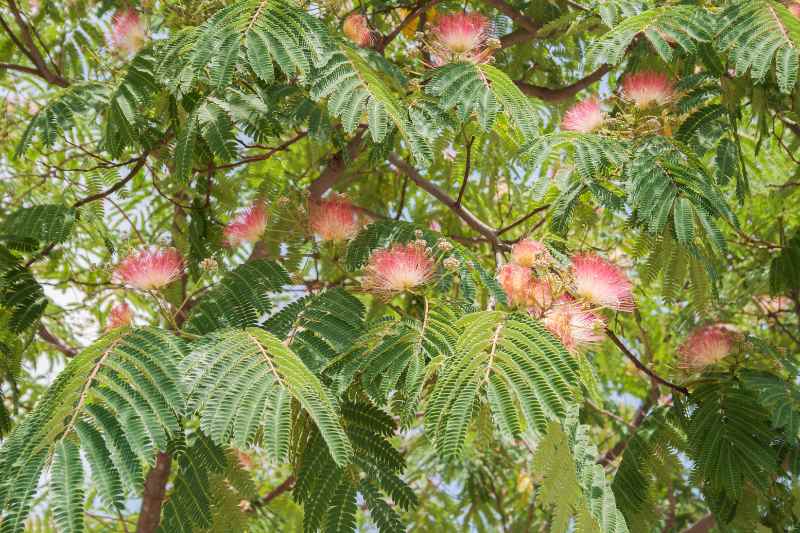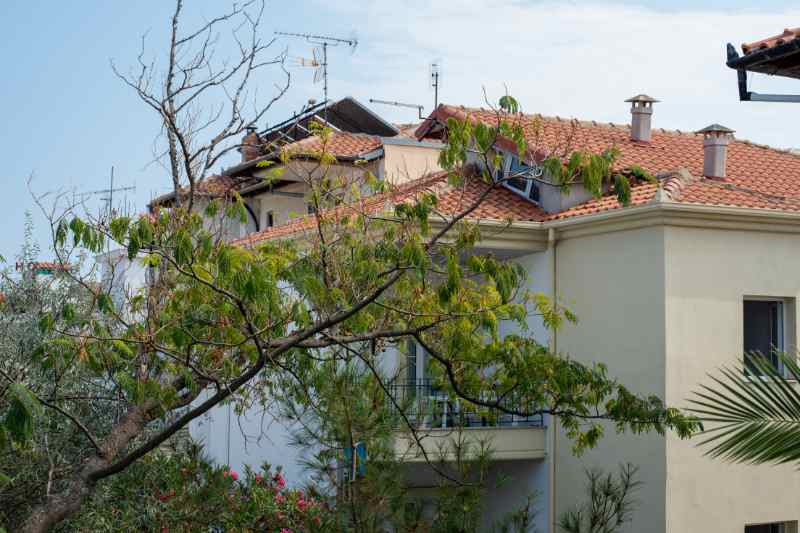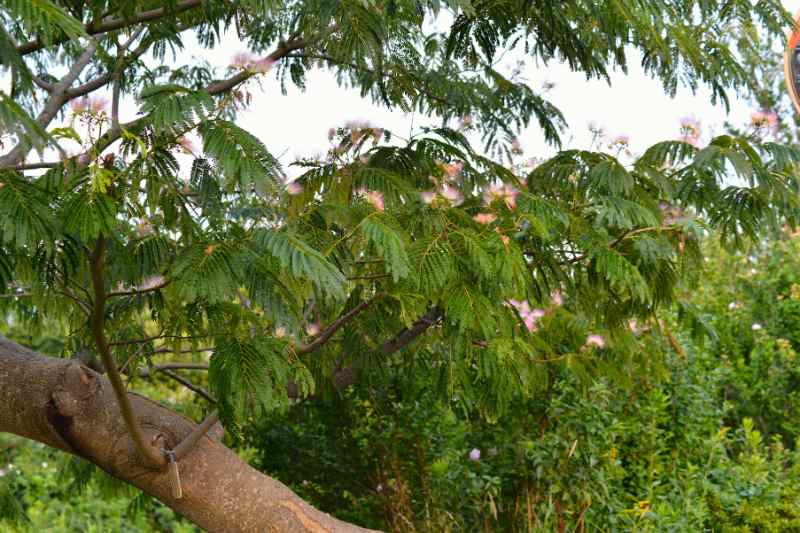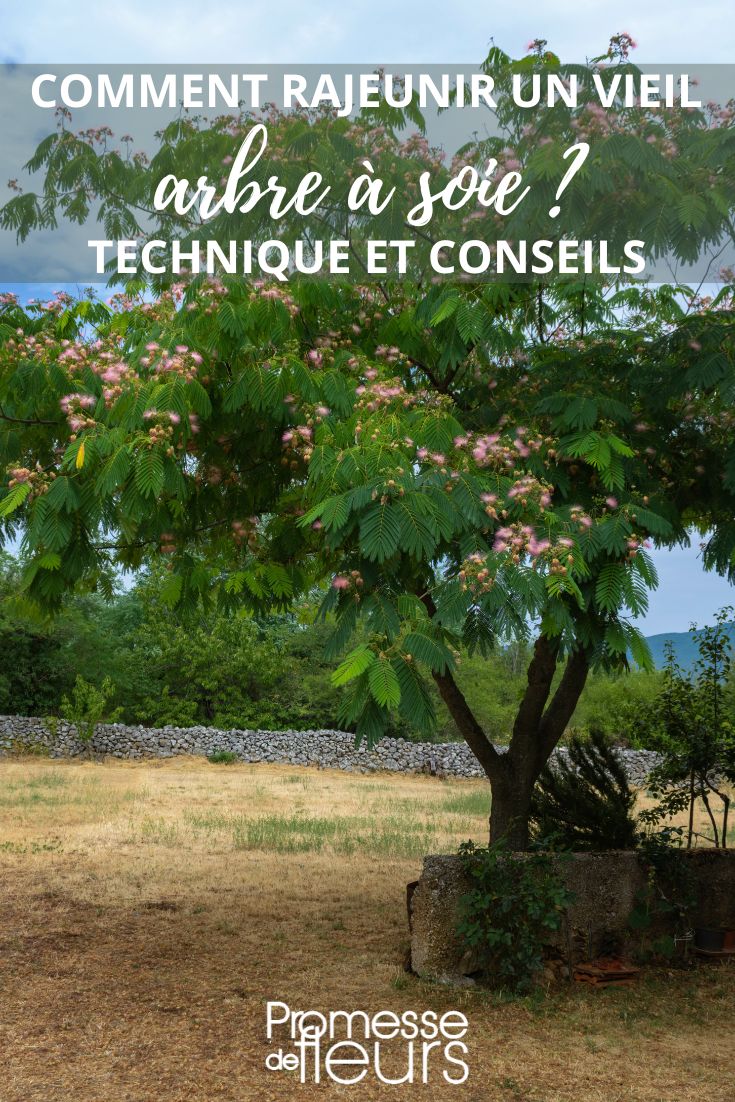Albizia, also called silk tree, is an elegant, exotic tree prized for its light foliage and magnificent feathery flowers. However, over time an Albizia can become unbalanced, lose vigour or produce fewer flowers. Fortunately, a good rejuvenation can restore its splendour! In this comprehensive guide, discover when and how to prune an ageing Albizia, which tools to use and mistakes to avoid to preserve your tree’s health. Follow these practical tips to give it a new lease of life!
A short note on Albizia
Albizia julibrissin, commonly known as silk tree, is a deciduous tree native to Asia, highly valued for its elegant, airy appearance. Its fine, delicate foliage, similar to that of a fern, gives it an ethereal look that dances with the slightest breeze. In summer it is adorned with magnificent silky pompom flowers, particularly attractive to bees and butterflies. Its rapid growth and great adaptability to warm, dry climates make it an ideal choice for providing shade and coolness in the garden. However, without basic maintenance it can lose its harmonious habit, decline and see its flowering reduce over the years.
Learn more about silk tree or Constantinople acacia in our datasheet Albizia: plant, prune and maintain.

Why rejuvenate an Albizia?
Over the years an Albizia can lose its splendour and show clear signs of ageing. Its habit often becomes unbalanced, with bare branches that spoil its appearance and weaken its structure. Flowering, once abundant, can become sparse or even disappear altogether, depriving the tree of its main attraction. Some branches become dry and brittle, increasing the risk of breakage, while the trunk can weaken, making the tree more vulnerable to disease and severe weather.
Rejuvenation pruning is essential to reinvigorate the tree. It stimulates the emergence of new vigorous shoots, promoting denser foliage and more generous flowering. By removing dead wood and unnecessary branches, it also helps rebalance the tree’s silhouette, restoring a more harmonious appearance. Finally, a well-maintained Albizia is naturally more resistant to disease, parasitic organisms and climatic hazards, thereby ensuring its longevity and good health.
How to tell if your Albizia needs pruning?
An Albizia typically begins to show signs of ageing from 15 to 20 years, although this depends on growth conditions and the maintenance it has received over the years. A well-cared-for tree will remain vigorous longer, while an Albizia left without pruning or care may need rejuvenation earlier.
You can tell an Albizia needs pruning when:
- Its habit becomes unbalanced: some branches grow excessively long while others become bare, giving the tree an irregular silhouette.
- Its flowering decreases: if the tree produces fewer flowers, or none at all, it is a sign of lack of vigour.
- Dry or dead branches appear: they may be brittle or leafless, which harms both appearance and health of the tree.
- The trunk seems weakened: cracks, fungi or irregular thickening of the bark can indicate decline.
- The tree becomes too dense: extremely dense interior foliage in the branches prevents light penetration and limits ventilation, promoting disease.

When to intervene to rejuvenate an Albizia?
The best time to rejuvenate an Albizia is late winter, before vegetation resumes (February–March). At this time:
- Sap is not yet circulating heavily, reducing risk of bleeding.
- The tree is dormant, so it tolerates severe pruning better.
- The tree’s structure is clearly visible, which makes cutting easier.
Avoid pruning in mid-summer, as this could weaken the tree and reduce its flowering.
Necessary equipment
- Pruning shear well sharpened for small branches
- Pruning saw for thicker branches
- Loppers or branch cutter for medium-diameter twigs
- Tool disinfectant (90% alcohol)
- Gloves and safety goggles to avoid preventable injuries
How to rejuvenate an Albizia?
Observing the tree
Before pruning, step back to analyse its structure:
- Where are dead or damaged branches?
- Are there branches that cross or unbalance the tree?
- Which twigs appear most vigorous?
Detailed steps
- Remove dead wood and damaged branches: cut out all dead, diseased or broken branches at their base, leaving no stub.
- Reduce main branches: shorten overly long branches to rebalance the tree, cutting just above an outward-facing bud. Do not reduce more than one third of their length to avoid weakening the tree.
- Thin out the tree’s centre: remove branches growing towards the interior to aerate the branches and allow light to penetrate better.
- Monitor and care after pruning: water moderately and add some compost at the base of the tree to stimulate recovery and strengthen its vigour.

Mistakes to avoid
- Avoid pruning in summer or during strong sap flow: the tree may weaken and heal less well.
- Do not cut back too short: excessive pruning would slow recovery and weaken the tree.
- Always disinfect tools: using non-disinfected tools can transmit disease to the tree.
- Remember to aerate the branches: an overly dense tree will lack light and vigour, which harms growth and flowering.
































Comments